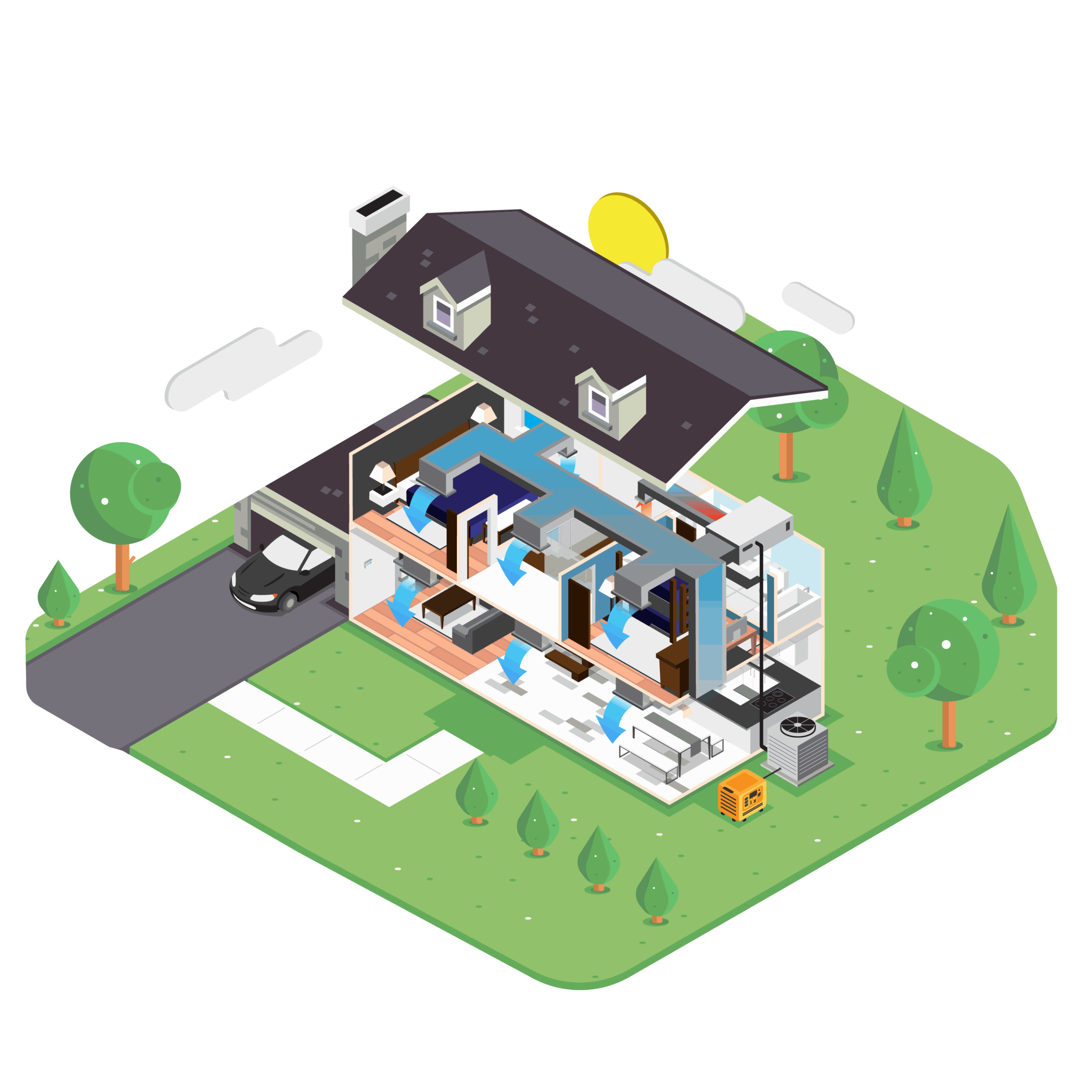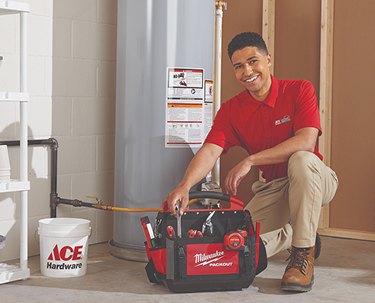
Power outages cost Americans $150 billion a year (via Department of Energy). With recent catastrophic storms causing days to week-long power outages, you don’t want to be caught unprepared. A backup generator will ensure that you are prepared for storms, hurricanes, and other severe weather conditions that can cause a power outage. We highly recommend purchasing and installing a generator before you are in an emergency power outage situation, attempting to set it up with a flashlight in a storm.
Before you go out to buy a generator, it’s important to understand that the size of your home and your energy needs determine which size and type of generator is right for you.
Types of Generators for Home Use
Whole Home Generators (or Standby Generators)
Whole home generators, also known as standby generators, are the best choice for home use. They are one of the more expensive types of generators, but come with extra features like self-diagnosis to indicate when maintenance is needed. They are also more powerful than other generators, and range from around 5,000 to 20,000 watts. A standby generator can power your entire house, or select circuits. They range in cost from $2,000 to $10,000, depending on the size and features.
Whole home generators automatically start up when your power goes out. They passively monitor the electricity provided by your utility company, and will turn on and begin powering your equipment, usually within seconds of the power outage.
They are permanently installed, so that it is always on standby to power your home. It does need to be installed by a professional, as improper installation can be dangerous. However, if correctly installed, standby generators are considered to be one of the safest generators.
Standby generators can be powered in various ways: propane, natural gas, gasoline, solar energy, or diesel. Some generators allow you to switch between fuel types. These are called Bi-Fuel or Tri-Fuel Generators, or Hybrid Generators.
Portable Generators
Portable generators are less expensive than standby generators, ranging from a few hundred dollars to a few thousand. Like the name implies, they are not permanently installed, but can be moved around and stored when not in use. They typically run on gasoline, and range from roughly 3,000 to 9,000 watts.
It is important to note that they cannot be installed in an enclosed space because of the potential for carbon monoxide (CO) poisoning. They must be at least 20 feet away from the house and from any HVAC equipment you have outside, and the exhaust needs to be directed away from your and your neighbors’ homes.
Inverter Generators
Inverter generators are also portable, but slightly more expensive than portable generators, as they have a more complicated design. Instead of running constantly they throttle up and down, and have a sophisticated exhaust system. As a result, they run much quieter and are more efficient than other types of generators.
Inverter generators come in a wide range of sizes, from ones that can power an entire house, to handheld versions with low power output. They range from 1,500 to 8,000 watts, and typically cost in the range of $400 to $4,000, depending on size.
Considerations for Your Home
Uses
If you would like to periodically use your generator while camping or for other use-cases not on your property, then you might want to purchase a portable or inverter generator.
Features
Generators come with all different types of features. Here are some common features that you should consider when deciding which generator is best for your needs. Not all types of generators have all of these features, so that should factor into your decision when choosing between a standby generator, portable generator, or inverter generator.
Automatic CO shutoff: This is a safety feature that shuts off your generator if it detects dangerous levels of carbon monoxide. While you should never run your generator in an enclosed space or in a way that would cause CO buildup, this feature offers a second level of safety to protect you and your family.
Fuel gauge: During a long blackout, it is helpful to be able to see at a glance how much fuel you have left.
Low-oil shutoff: This feature prevents damage to your generator by automatically shutting off if the oil runs low.
Electric start: This means that you start the generator by pushing a button, rather than a pull-start.
Automatic start: A generator with automatic start will automatically turn on when a power outage is detected. Standard with standby generators.
Multiple outlets: For portable generators, having multiple outlets lets you spread the wattage load and get better results from your generator.
Sizing
Generators are sold by power output, in watts. The general rule of thumb is that a typical home needs about 5,000 – 7,000 watts, but of course, this will vary. We recommend making a list of the appliances you’ll need to run while the power is out, then add up the wattages in order to get an estimate of how much power you’ll need to generate. This will probably include your refrigerator, your HVAC system, lighting, and any other necessary devices that run on electricity, like an electric water heater or range. You’ll also want to add on some more watts for charging a computer or phone.
If you want your entire house to operate as normal, then consider adding on things like your washer and dryer, dishwasher, TVs, security system, and so on. However, consider that the higher wattage generator you buy, the more expensive it will be — so if you want to spend less money, you may want to buy a smaller generator that will power only the necessities.
Once you have an idea of how many watts you require, add on about 10-20% more as a buffer, which will give you some more flexibility in the future, like if you purchase a new appliance, or replace an old one with one that requires higher wattage. Now you know what size generator you need, and can begin looking for the right one.
The experts at Unique Indoor Comfort will help you get the right sized generator for your power needs and keep it running through every power outage. We can help you select the perfect generator for your home and energy needs, handle the installation, and perform regular maintenance on your generator system to ensure that it’s operating at maximum efficiency.
Want to learn more about generators?
Have more questions, or are interested in installing a generator in your home? The experts at Unique Indoor Comfort would love to help!
FAQ’s
How long does it take to install a generator?
Residential generator installs can take anywhere from one to four days. It’s typical for the electrical installation to take one full day on a 2,000 sqft single family home. The gas installation usually happens on a separate day and can range from half a day to a full day.
How much does it cost to install a generator?
Installation cost typically ranges from $10,000 to $20,000 and varies depending on the length of time required to install the unit, plus the cost of equipment required.
What are the different generator options? Can I customize a generator for my home?
There are several options for generator solutions: Portable versus standby, air-cooled versus liquid cooled, or whole house versus selected circuits, with many possible combinations. While you can’t create a custom generator from scratch, your generator solution can be tailored to your needs.
Does installing a generator affect homeowners insurance?
Most likely not. There are some insurers that offer discounts for generators, but these are usually minimal.



